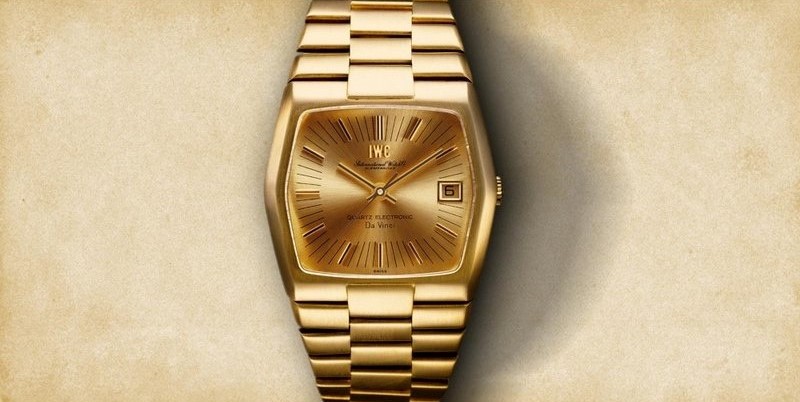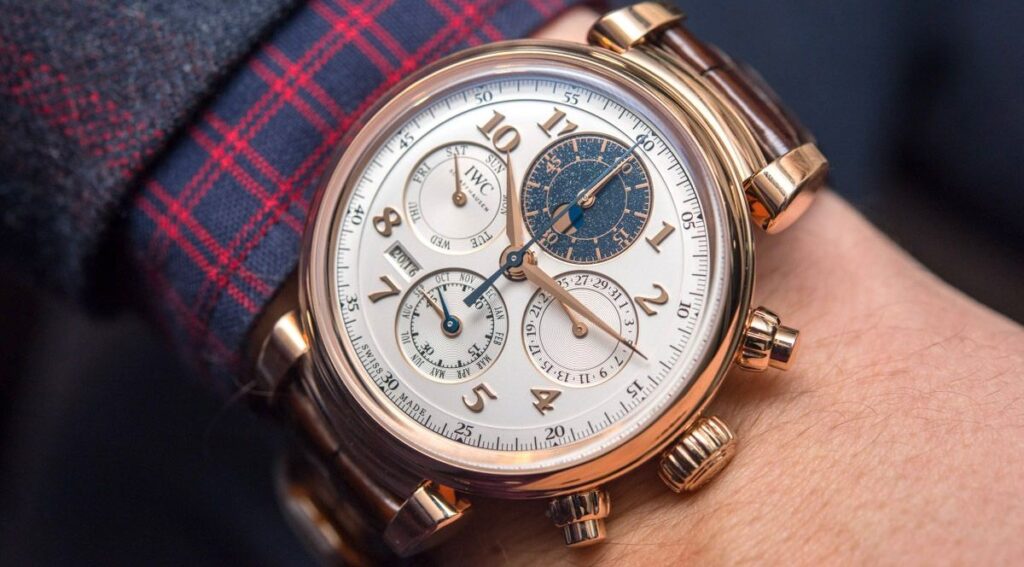“Da Vinci” Design
Leonardo Da Vinci was a powerful innovator, inventor, and mind in human intellectual history. His ideas, design, and artistry have inspired countless individuals to dream and create for ages. Much akin to this groundbreaking individual, IWC’s 1985 Da Vinci was a perpetual calendar watch that set a new standard for innovation in watchmaking. So much so that other variations of this “ref. 3750” design from IWC are still spoken about in horological circles—nearly 35 years from its 1985 release. Though IWC has top sellers in its other styles (Big Pilot’s and Portugeiser), the Da Vinci is arguably the brand’s most groundbreaking watch line. It is a wristwatch series of firsts both inside and outside of IWC, but it took some time to reach its highest heights of success.
Origins and the Beta 21 QTZ

In the late 1960s Swiss watchmakers were trying to get ahead of the curve with a new revolution in watchmaking—the quartz movement. What was to become a full blown crisis for Swiss watchmakers was looming just over the horizon; It was during this time that the Swiss really wanted to match the cost efficiency and accuracy of Japanese quartz movements. As a result, a quartz movement dubbed the Beta 21 was developed by 21 watchmakers (thus the name) with IWC included. After lending their support for the Beta 21 IWC began designing a watch to house this new electronic component. Being IWC’s very first watch to implement the Beta 21, the Da Vinci Quartz Electronic was a unique move for their otherwise mechanical brand. Regarding uniqueness—the case design for the 1969 Beta 21 Da Vinci Quartz Electronic was hexagonal. It’s an alien looking case design compared to their contemporary luxury designs, which feature more sleek and rounded features. However it was this boldness—combined with the Beta 21 movement—that made this a viable, reliable, and unique timepiece through the 1970s.
By the 1980s it was considered niche to return to making mechanical watches for most watch brands. There were very few folks left—other than collectors and the like—who wanted new ideas in mechanical watchmaking. But after a few evolutions of the Da Vinci Quartz Electronic and the Beta 21 movement, IWC wanted to try something new with the Da Vinci watch line. This switch back to a mechanical movement would prove to be a great step forward in reinvigorating mechanical watchmaking.
Da Vinci Perpetual Calendar
This watch of firsts was developed under the powerful guidance of master watchmaker/engineer Kurt Klaus. Klaus was hired by then IWC Chief Executive Officer Günter Blümlein to develop sports watches. However—recognizing Kalus’s prowess for mechanical watch design—IWC put him front and center for a project later codenamed “Operation Eternity”. Being Klaus’s sort of Vitruvian Man, the Da Vinci Perpetual Calendar solidified his prowess in horological creativity. Retrospectively, the early draftings for this watch’s complications look like a series of Leonardo Da Vinci level instructions. When his vision was finally completed and manufactured, it debuted at the Basel Watch Fair in 1985—to massive fanfare. There were plenty of reasons for this: It was the first watch to integrate a perpetual calendar into an automatic chronograph movement, it was the first watch to have an autonomous perpetual calendar (which could be adjusted on the crown), and it breathed a breath of fresh air into an otherwise quartz dominated world. After its debut, it seemed that the art of complex mechanical watchmaking wasn’t going the way of the dinosaur.

A year after IWC dropped this bombshell into the world of watchmaking, they also debuted another first. In 1986 IWC released the first ceramic case wristwatch, with the Klaus designed Perpetual Calendar movement in tow. Giving the Da Vinci Perpetual Calendar watch a slick all black case design was a beautiful choice in terms of aesthetics. On top of this, it made the watch a whole lot more scratch resistant. The use of ceramic on watch cases has become a trademark of the watch industry ever since—if nothing else but to add a bit more luxury to both mid-range and high-end timepieces.
By 1995 fans of the 1985 release of the Da Vinci Perpetual Calendar saw a re-release of the Da Vinci watch line, alongside a few other newer releases. This ten year commemorative solidified the brand’s top sellers, as well as celebrated their innovations in the industry. A lot of their catalog was so successful up to that point that IWC still continues to recreate the Da Vinci and other classics to this day.
The Dates Roll On
IWC will likely continue the Da Vinci watch line for many many years to come. Through more recent years, up until now, IWC has continued to release new iterations of their Da Vinci—as well as “vintage” versions with their classic hexagonal case design. With half a century under its belt, the Da Vinci from IWC will retain its value as a strong player in the world of modern watchmaking. With the Da Vinci Perpetual Calendar bringing the art of complex mechanical watchmaking back to the mainstream, one can hope that another Kurt Klaus comes along to show us another great innovation in design. After all, it’s an art that has lasted nearly as long as the Da Vinci name itself—and is deserving of our greatest minds in engineering.
Times Ticking has been in operation for more than 30 years, since 1982. We have performed watch repair for customers both locally and internationally. If it Ticks! We KNOW it! Our team of watch repair technicians have a combined experience in watchmaking of over 120 years.

